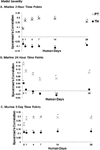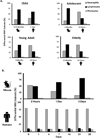A better understanding of why murine models of trauma do not recapitulate the human syndrome
- PMID: 24413577
- PMCID: PMC4283139
- DOI: 10.1097/CCM.0000000000000222
A better understanding of why murine models of trauma do not recapitulate the human syndrome
Abstract
Objective: Genomic analyses from blood leukocytes have concluded that mouse injury poorly reflects human trauma at the leukocyte transcriptome. Concerns have focused on the modest severity of murine injury models, differences in murine compared with human age, dissimilar circulating leukocyte populations between species, and whether similar signaling pathways are involved. We sought to examine whether the transcriptomic response to severe trauma in mice could be explained by these extrinsic factors, by utilizing an increasing severity of murine trauma and shock in young and aged mice over time, and by examining the response in isolated neutrophil populations.
Design: Preclinical controlled in vivo laboratory study and retrospective cohort study.
Setting: Laboratory of Inflammation Biology and Surgical Science and multi-institution level 1 trauma centers.
Subjects: Six- to 10-week-old and 20- to 24-month-old C57BL/6 (B6) mice and two cohorts of 167 and 244 severely traumatized (Injury Severity Score > 15) adult (> 18 yr) patients.
Interventions: Mice underwent one of two severity polytrauma models of injury. Total blood leukocyte and neutrophil samples were collected.
Measurements and main results: Fold expression changes in leukocyte and neutrophil genome-wide expression analyses between healthy and injured mice (p < 0.001) were compared with human total and enriched blood leukocyte expression analyses of severe trauma patients at 0.5, 1, 4, 7, 14, and 28 days after injury (Glue Grant trauma-related database). We found that increasing the severity of the murine trauma model only modestly improved the correlation in the transcriptomic response with humans, whereas the age of the mice did not. In addition, the genome-wide response to blood neutrophils (rather than total WBC) was also not well correlated between humans and mice. However, the expression of many individual gene families was much more strongly correlated after injury in mice and humans.
Conclusions: Although overall transcriptomic association remained weak even after adjusting for the severity of injury, age of the animals, timing, and individual leukocyte populations, there were individual signaling pathways and ontogenies that were strongly correlated between mice and humans. These genes are involved in early inflammation and innate/adaptive immunity.
Conflict of interest statement
Conflict of Interest Statement: No conflict of or competing interests have been declared.
Figures




Comment in
-
Genetic correlations between murine and human trauma: time to focus only on highly selected genetic pathways.Crit Care Med. 2014 Jun;42(6):1552-3. doi: 10.1097/CCM.0000000000000260. Crit Care Med. 2014. PMID: 24836793 No abstract available.
References
-
- Probst C, Pape HC, Hildebrand F, et al. 30 years of polytrauma care: An analysis of the change in strategies and results of 4849 cases treated at a single institution. Injury. 2009;40(1):77–83. - PubMed
-
- Davidson GH, Hamlat CA, Rivara FP, et al. Long-term survival of adult trauma patients. JAMA. 2011;305(10):1001–1007. - PubMed
-
- Dyson A, Singer M. Animal models of sepsis: why does preclinical efficacy fail to translate to the clinical setting? Crit Care Med. 2009;37(1 Suppl):S30–S37. - PubMed
Publication types
MeSH terms
Grants and funding
- R24 GM102656/GM/NIGMS NIH HHS/United States
- U54 GM-062119-10/GM/NIGMS NIH HHS/United States
- T32 GM008721/GM/NIGMS NIH HHS/United States
- K23 GM-087709/GM/NIGMS NIH HHS/United States
- P30 AG028740/AG/NIA NIH HHS/United States
- P30AG028740/AG/NIA NIH HHS/United States
- R01 GM097531/GM/NIGMS NIH HHS/United States
- K23 GM087709/GM/NIGMS NIH HHS/United States
- R01 GM040586/GM/NIGMS NIH HHS/United States
- R01 GM-80576-06/GM/NIGMS NIH HHS/United States
- T32-GM-008721-13/GM/NIGMS NIH HHS/United States
- U54 GM062119/GM/NIGMS NIH HHS/United States
- R01 GM-40586-24/GM/NIGMS NIH HHS/United States
LinkOut - more resources
Full Text Sources
Other Literature Sources

